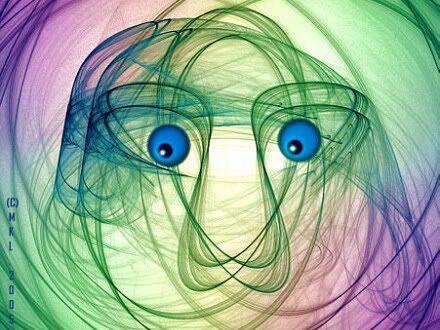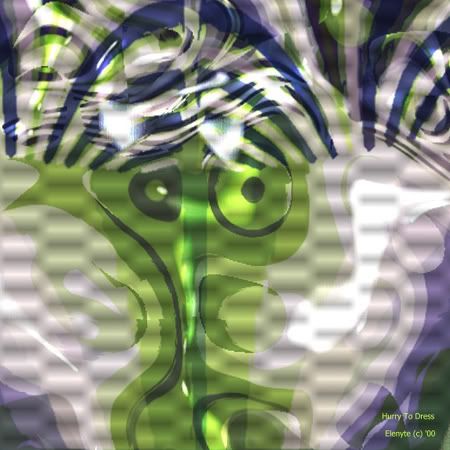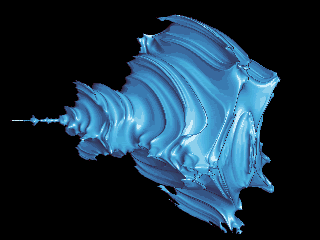Infinite Jest?
Slimazoids Visit Gnarlinspike Badlands by Garth Thornton.
One of the hardest parts of my job is figuring out what other people will think is funny. You’d think that would be easy, but my own sense of humor is far from the mainstream. I can’t assume others will laugh at the same things I find funny.
--Scott Adams, Dilbert cartoonist
Tap. Tap tap. Is this thing on?
Oh. Hi. Hey. Thanks for coming. Say. If you're like me. Have you ever wondered...
What's easier artistic material? Tragedy or comedy?
As a writer, I've always found comic themes more difficult to pull off than tragic ones. Maybe that's because most of us are more likely to agree on what constitutes a tragedy. But evoking laughter in a reader -- well, good luck.
And I wonder if amusing a viewer with a visual image isn't twice as difficult. After all, the perceiver of the image generally has only visual cues for clues. Often, there's no narrative set-up. No underlying context. No cathartic punch line.
Garth Thornton, one-half of the creative team behind Xenodream, walks the fence very effectively in the image above. The caption provides the context for appreciating the joke -- that is, there is a deliberate, conscious attempt to steer viewers to see Thornton's humorous point-of-view.
And, really, there's nothing wrong with guiding viewers to intended interpretations. There have been discussions back in Orbit Trap's salad days over whether images have inherent political content -- or if such a subtext is created only by the act of titling. Some fractal artists insist on not titling images, or are prone to using only numerical titles. Such practices, they argue, do not pressure viewers into making assumptions about thematic content and allow the broadest latitude to form individual interpretations.
My response would be that viewers are always free to forage in images and come up with their own idiosyncratic, thematic angles. Titles and captions don't contaminate interpretation; they merely suggest one possibility that occurred to the artist. And why shouldn't artists provide viewers with possible road maps, especially if artists hope to imply political, social, technological, horrific, and, yes, even comic overtones.
But humor, because it is so inherently subjective, is extremely hit or miss. And all the more so if visual clues come off as vague or garbled when "read."
I'm certainly not the first artist to dwell on this subject. From "'Snot Funny: Humor and Art" by Kate Alexander:
It is difficult to think of humor and intellect as going hand-in-hand: just like the divisions of mind and body, humor is considered base, and mutually exclusive to higher cognition. After all, humor is very corporeal: laughter is the physical response to something funny. If you have any doubts of this, just consider these questions: did Jesus laugh? Can you imagine Muhammad telling a joke? Or Buddha, mid-meditation, passing gas and giggling?
This very issue has repercussions in art as well. The function of art has, for several centuries now, been expected to fulfill some philosophical purpose. Art is supposed to make us think. This especially overwhelmed art in the wake of the Conceptual Art movement, as artistic skill was thrown out the window, and the "idea" reigned supreme. It is thus that we separate the high arts from the low arts: art that is "funny" is not respectable.[...]
But, some might say, if the separation of high art and low art did not exist, art would be indistinguishable from mere "entertainment:" a Peanuts comic strip would be as aesthetically valuable as a Bruce Nauman; Will Ferrell would be more of a mover-and-shaker than Sol LeWitt; Andy Samberg's crude SNL digital shorts would be as artistically legitimate as a Jean-Luc Godard film. I myself try to fight the elitist reputation of art historians, but all I have to say is: yikes.
The profiling couldn't be any clearer. Tragedy is high art. Comedy is lowbrow. The plank to the back of the head in Laurel and Hardy. The poke in the eyes by Moe Howard. The snickering you try to stifle when a friend clumsily misses the last stair step. These are the pulled fingers of low culture. The true intelligentsia prefers a more royal approach: We are not amused.
Yes, it's far easier to show angst and anger in one's art -- or just title an image with some ominous, obtuse phrase to ensure maximum heaviness. Like Nascar Bazaar. Or throw out reason entirely and just make shit up on the spot like Janet Parke. How about: Tressione. Or: Asundriana. Well, are you laughing -- or bowled over by the ponderous connotations -- or just beginning to feel the first flushes of weepiness?
It's far easier to imply something serious than it is to venture into comedy's minefield. After all, exactly what kind of a reaction do you intend? Which of the following do you hope your freshly minted comic image brings forth: mild amusement, a touch of mirth, extreme rib-tickling, presidential smirking, ironic elbowing of shared insights, sarcasm leading to furious fist-pumping, slapsticky pratfall guffawing, parody or insult or blunder or pranking? Look at all the wrong exits your poor viewer can take. Maybe that's why titles or captions can sometimes serve as a kind of pre-set, interpretive GPS system.
Still, it's so easy to get lost in the comedy forest:
Pretty funny, huh? Or, is it? It depends, I suppose, whether you feel the lion is:
1) sleepy, and has a groggy, foggy look that suggests a bit of whimsy, or
2) startled, and thus p'unked upon awakening to find you inexplicably hanging about the lair, or
3) hungry, making you potential and available cat food and the whole situation definitely not funny.
Or, how about this -- an image that shares some stylistic attributes with the previous one, yet does not necessarily lead to the same responses:
Is this funny? I guess it's your own call. Poelker's image always makes me smile, but I'd be hard pressed to explain in depth why I think it's funny. Something about its mix of implied chaos, a frenzy found in that captured moment, and the abstract, contorted body desperately trying to squeeze into clothing. Maybe you find all of this too familiar and therefore depressing. I don't know. Can't you see I've wandered into dangerous waters here? I mean: if you have to explain the joke, then...
Finally, mixing math and humor tacks on another grievous level that can result in blank looks rather than laughter. After all, "fractal humor" is probably a sub-genre of the broader "scientist humor" field. Often, such jokes rely on a rudimentary understanding of some genre-specific jargon and arcane knowledge. Here's a case in point. First, study the image, which appeared in the "Fractal Humor" section of the FractalForum message board:
Malformed Child by Dave Makin.
Posted to Fractalforums.com.
Now, follow along carefully as Makin lays out the joke for you:
This is z^2+c where z and c are a 3D system i.e. not fully 4D.
It looks like the malformed offspring of a quaternionic Mandy and a hypercomplex Mandy [smiley].
Well, kids, isn't that funny? Isn't it? Or, as they say, did you have to be there?
Tags: fractal, fractals, fractal art, fractal blog, fractal humor, infinite jest, with apologies to david foster wallace, garth thornton, maria k lemming, elenyte paulauskas-poelker, dave makin, comedy vs tragedy, laugh like a programmer, cruelanimal, orbit trap








0 Comments:
Post a Comment
<< Home